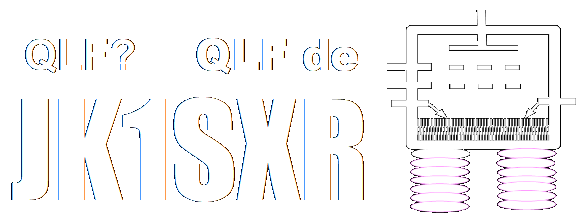
Snapshot No. 625-629
629. Jyuu-san ya (the Thirteenth Night)
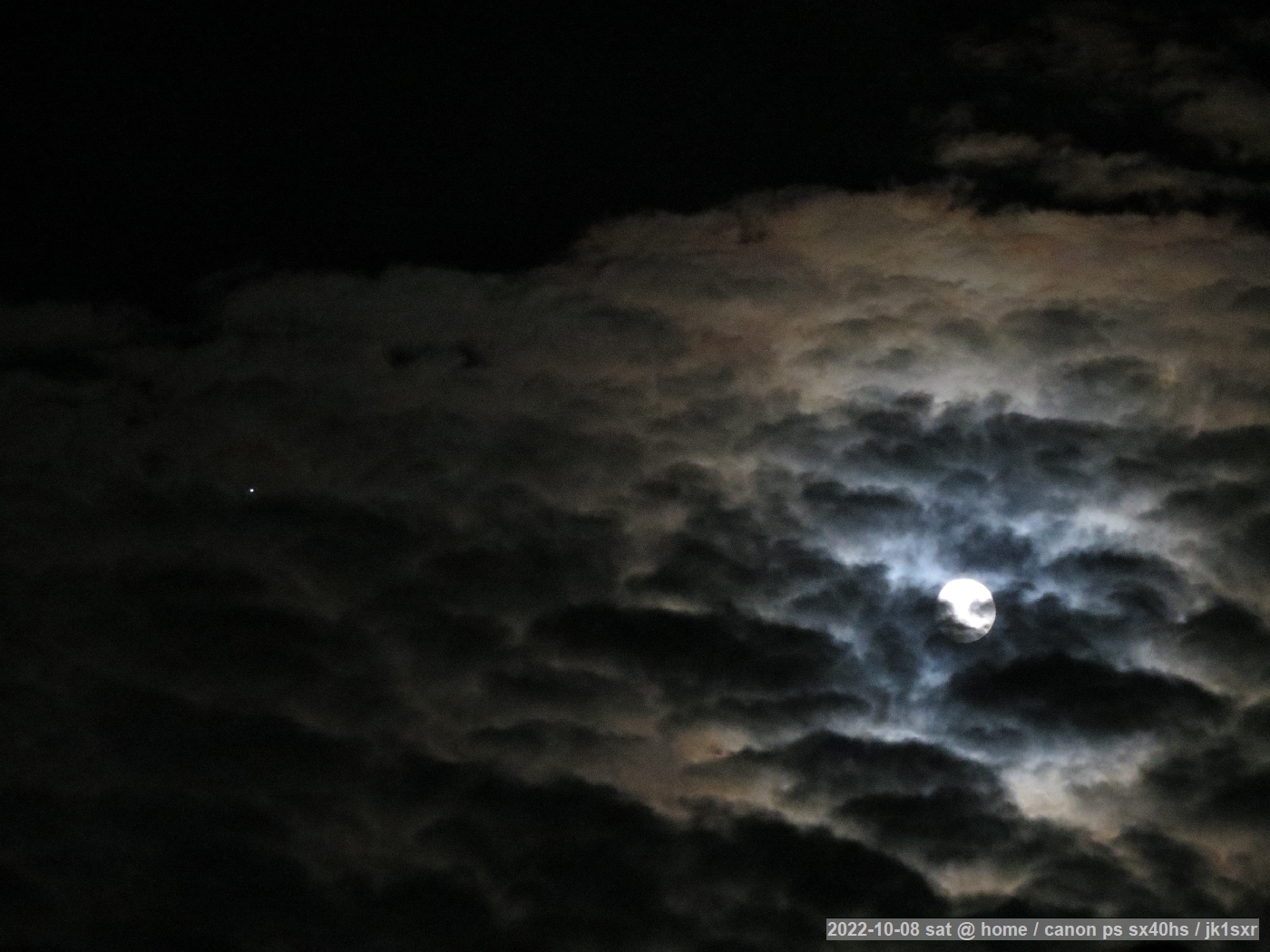 Today falls on the Sep. 13th acc. to the luni-solar calendar.
Today falls on the Sep. 13th acc. to the luni-solar calendar.
And the tonight's moon is called kuri meigetu, chestnut excellent moon (chestnuts, beans, etc. in season are offered to the moon).
"The thirteenth-night, no overcast" is said here. It looks, in the past, tonight was a singularity day of no cloud.
The tiny bright spot at the left middle of the photo is the Jupiter.
The Jupiter is now situated, seen from the sun, in the same direction of the Earth.
The science year book here indicates the semimajor axis of the Jupiter's orbit is 5.2 a.u.
Thus, the distance between the Earth and the Jupiter varies, the longest 5.2 + 1.0 = 6.2 a.u. and the shortest 5.2 - 1.0 = 4.2 a.u.
In these days, we are in this 4.2 a.u. period, and the Jupiter, in the evening, appears in the east sky with a surprizingly brilliant intensity.
628. Rindou
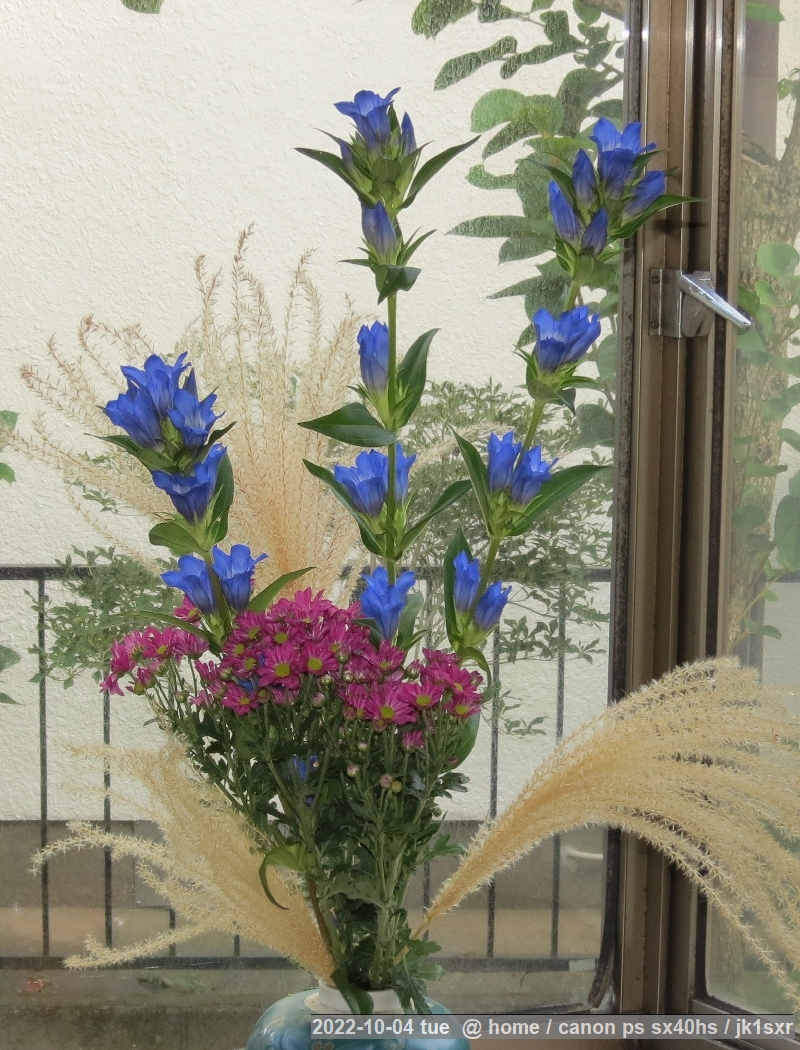 Rindou and kiku.
Rindou and kiku.
I mistook this rindou for kikyou, one of the autumn seven-herbs. The kikyou's petals are to open more widely.
Anyhow, it looks good enough for the offering to the 13th-day moon of this Saturday.
627. An excellent park
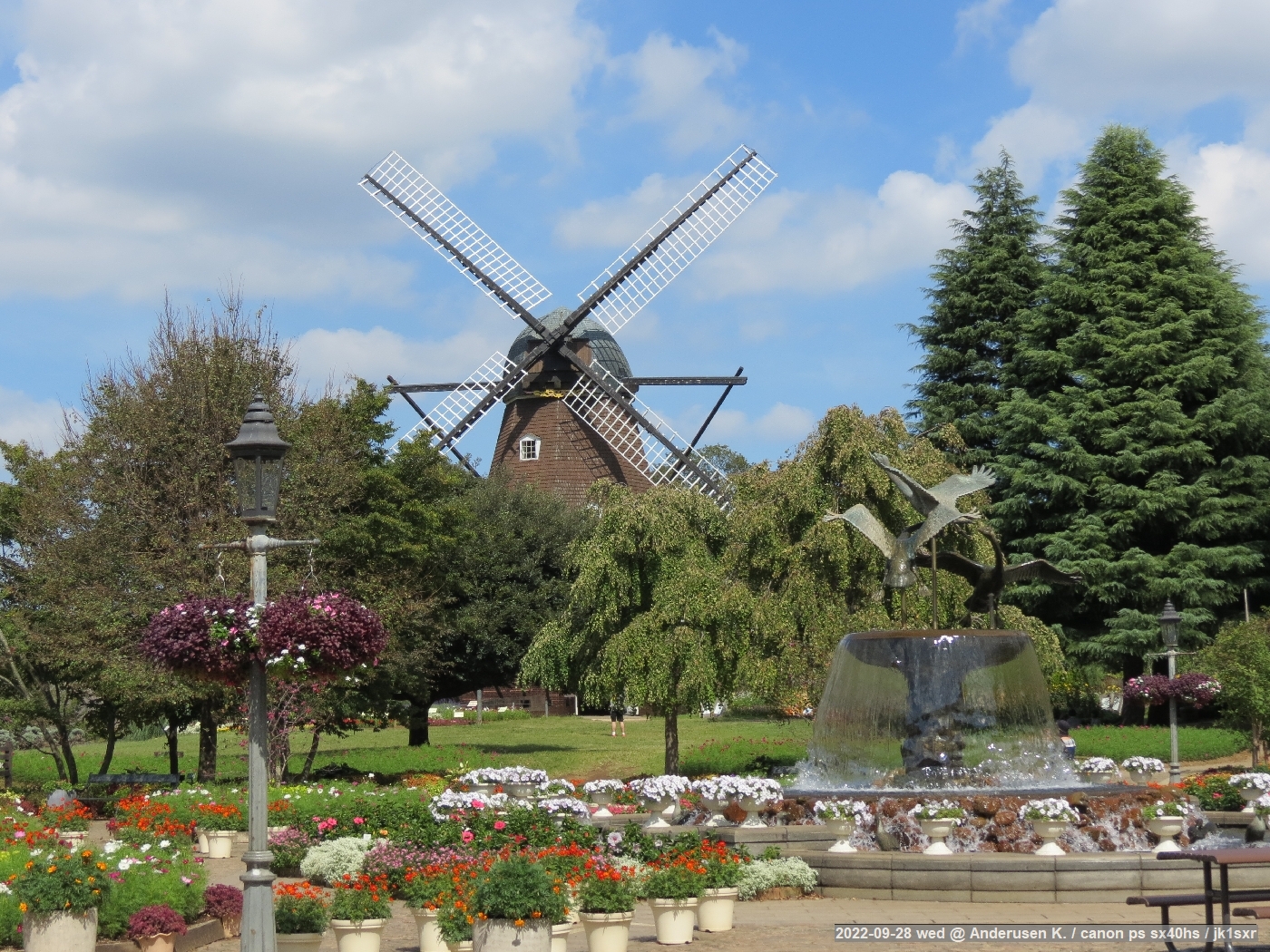 Autumn's clear skies brought us to the "Funabasi Anderusen Park".
Autumn's clear skies brought us to the "Funabasi Anderusen Park".
The park is neatly managed and very good for a walk, especially in a weekday.
However, in the beginning, the name made me think of the frequently-seen place where fake stuffs are simply displayed, and I always passed by.
The park's name, of course, refers to the fairy-tale writer, H.C. Andersen.
He was active during the period of Bunka Bunsei - late Edo period - Meiji Restoration here, and not the person of the distant past.
BTH, it is said that H.C. Oersted who's name is adopted in the magnetic-field unit "Oe" was a close friend of H.C. Andersen.
The then Denmark was in such a miserable situaion as to it had to declare "state bankruptcy" because of the conflicts among the nordic countries, a big fire in Copenhagen, attacks by the English navy, etc. However, strangely enough, in the fields of arts and science, it was the time, later called, "Danish Golden Age".
We can recognize that this type of intriguing period could happen, if we consider, for instance, the Muromati period.
Well, sorry, that was another strory. Back to the park.
Funabasi established, in 1989, a sister-city relationship with Odense, Denmark which is the birthplace of H. C. Andersen. With the assistance of Odense, Funabasi has built the park with the theme of Andersen's fairy-tale world and the 19th-century Danish rural landscapes.
It looks that the timely investment to the facilities based on a reasoned concept and tireless maintenance have made this park best of the best.
626. A transposition pylon
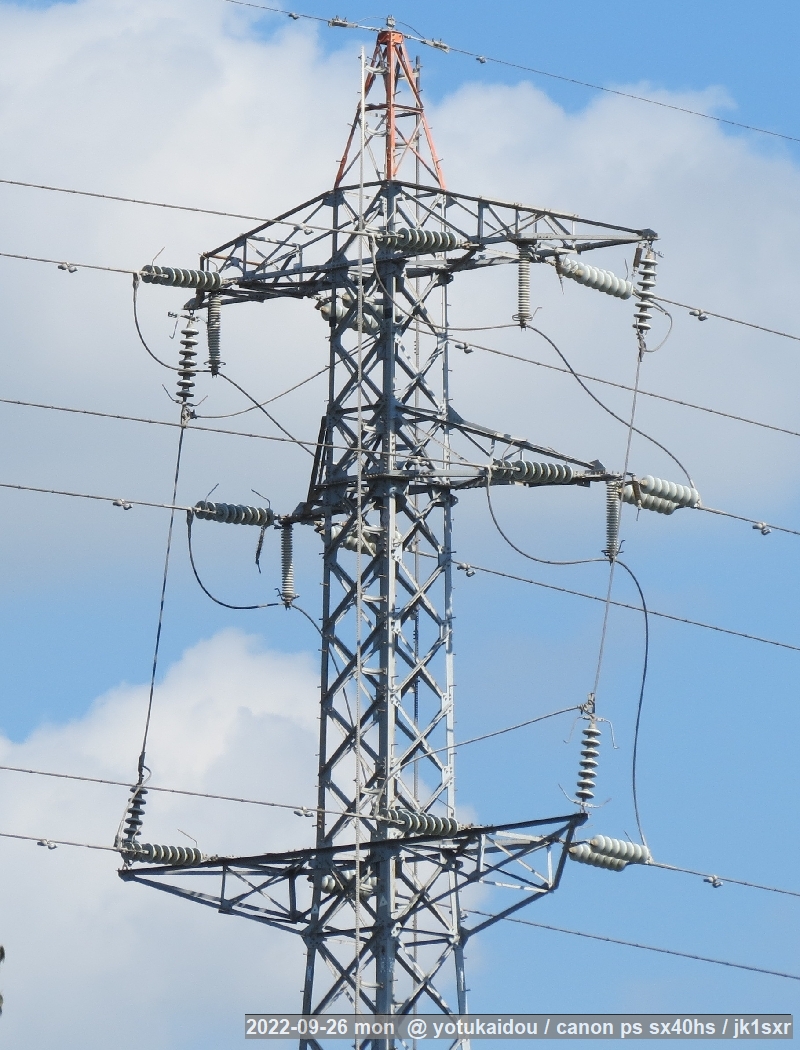 A 66 kV pylon at the Yotu-kaidou athletic park.
A 66 kV pylon at the Yotu-kaidou athletic park.
As in the photo, this is a bit rare "transposition tower".
At the circuit in the front, the upper, middle and lower lines at the tower left are transposed to the middle, lower and upper positions respectively at the right. The same is true for the circuit behind.
This transposition is to prevent the unbalanced currents by the difference in the capacitance to the ground of each phase, which becomes appreciable with the transmission line length.
This type of tower is adopted at a distance, approximately equal to the value, the voltage value in kV multiplied by 1 km. Thus, in 66 kV lines, about 60 km, and in 275 kV, 270 km. This is why this tower is rarely seen, even if the textbook describes it.
Until today, I have seen this type of pylon only 3 times including this one. The other is at Miho close to Kasumigaura, and another seen briefly elsewhere.
625. A drawbridge
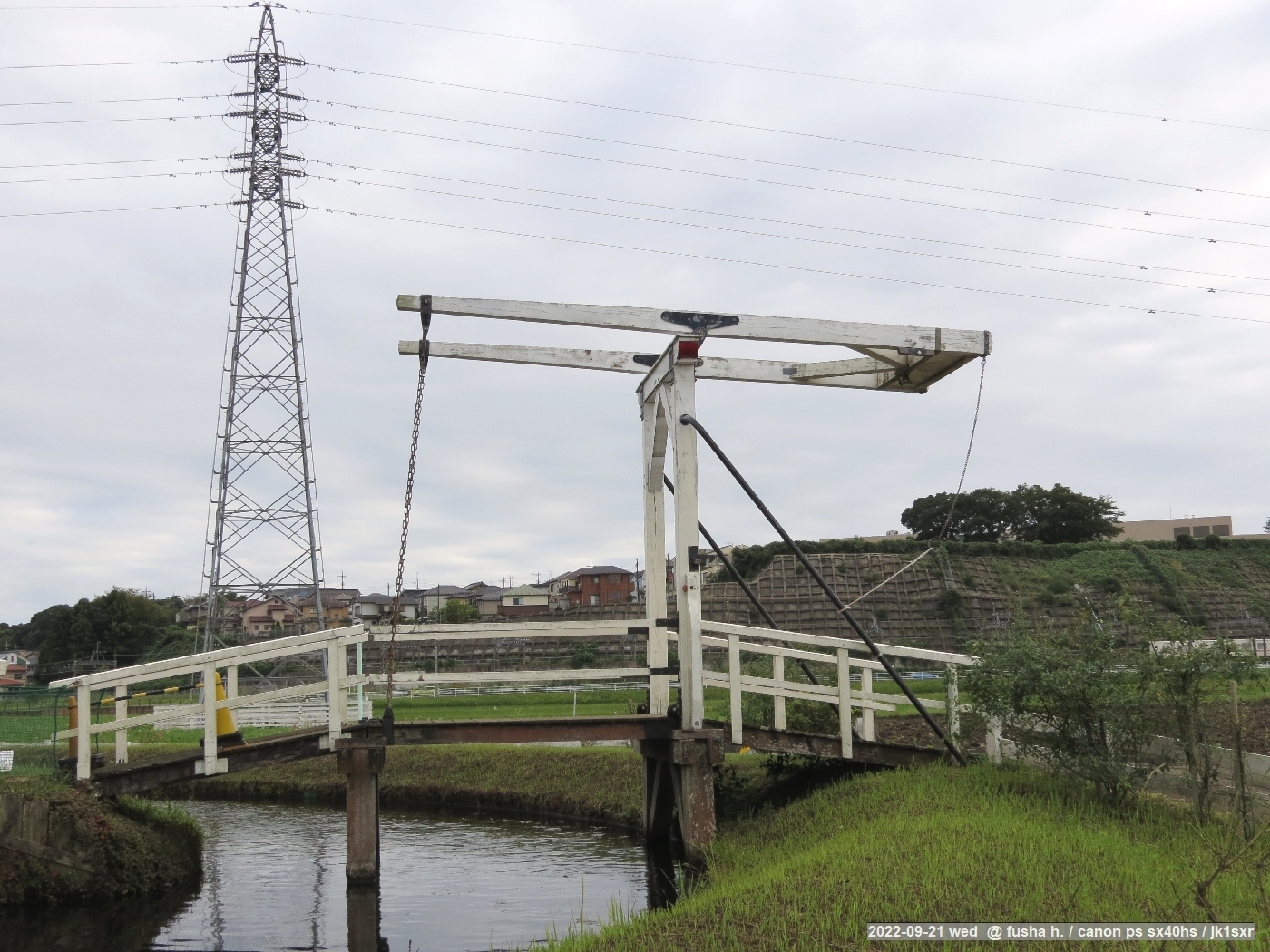 A drawbridge.
A drawbridge.
It is situated in front of the windmill tower entrance located at the side of Inba marsh.
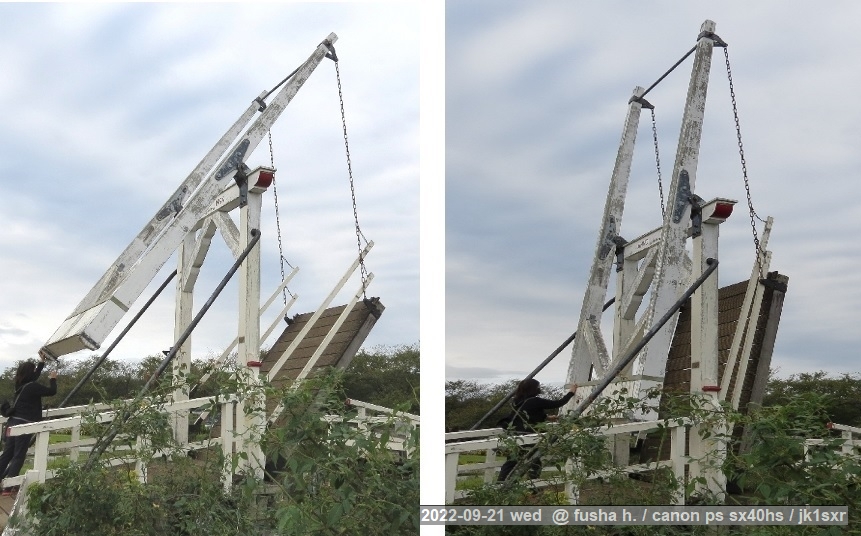 The right shows the bridge being pulled up.
The right shows the bridge being pulled up.
As is obvious, the bridge weight and the opposite counter weight seem to be balanced, and the bridge is raised lightly with a thin rope.
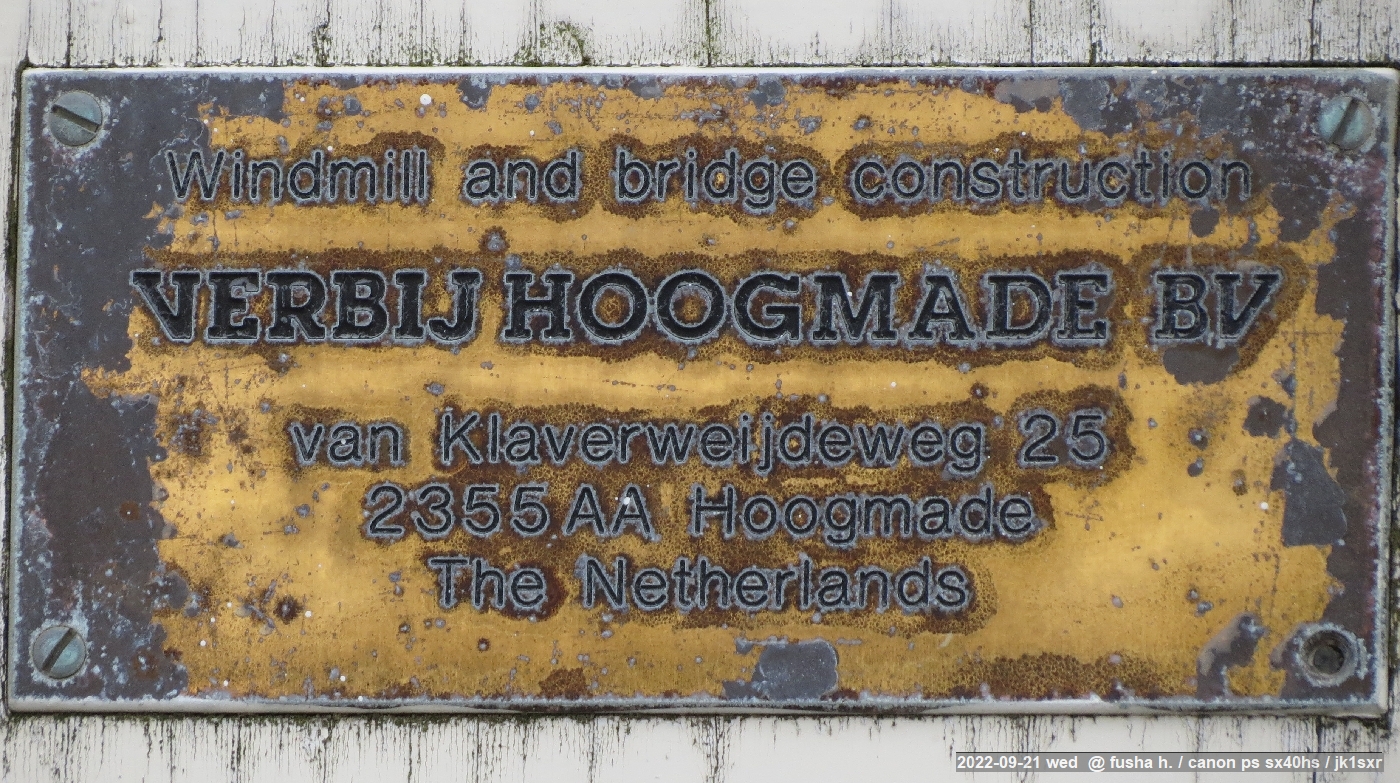 The nameplate of Dutch maker who made the major mechanism of the windmill and the bridge.
The nameplate of Dutch maker who made the major mechanism of the windmill and the bridge.
629. Jyuu-san ya (the Thirteenth Night)
 Today falls on the Sep. 13th acc. to the luni-solar calendar.
Today falls on the Sep. 13th acc. to the luni-solar calendar.And the tonight's moon is called kuri meigetu, chestnut excellent moon (chestnuts, beans, etc. in season are offered to the moon).
"The thirteenth-night, no overcast" is said here. It looks, in the past, tonight was a singularity day of no cloud.
The tiny bright spot at the left middle of the photo is the Jupiter.
The Jupiter is now situated, seen from the sun, in the same direction of the Earth.
The science year book here indicates the semimajor axis of the Jupiter's orbit is 5.2 a.u.
Thus, the distance between the Earth and the Jupiter varies, the longest 5.2 + 1.0 = 6.2 a.u. and the shortest 5.2 - 1.0 = 4.2 a.u.
In these days, we are in this 4.2 a.u. period, and the Jupiter, in the evening, appears in the east sky with a surprizingly brilliant intensity.
628. Rindou
 Rindou and kiku.
Rindou and kiku.I mistook this rindou for kikyou, one of the autumn seven-herbs. The kikyou's petals are to open more widely.
Anyhow, it looks good enough for the offering to the 13th-day moon of this Saturday.
627. An excellent park
 Autumn's clear skies brought us to the "Funabasi Anderusen Park".
Autumn's clear skies brought us to the "Funabasi Anderusen Park".The park is neatly managed and very good for a walk, especially in a weekday.
However, in the beginning, the name made me think of the frequently-seen place where fake stuffs are simply displayed, and I always passed by.
The park's name, of course, refers to the fairy-tale writer, H.C. Andersen.
He was active during the period of Bunka Bunsei - late Edo period - Meiji Restoration here, and not the person of the distant past.
BTH, it is said that H.C. Oersted who's name is adopted in the magnetic-field unit "Oe" was a close friend of H.C. Andersen.
The then Denmark was in such a miserable situaion as to it had to declare "state bankruptcy" because of the conflicts among the nordic countries, a big fire in Copenhagen, attacks by the English navy, etc. However, strangely enough, in the fields of arts and science, it was the time, later called, "Danish Golden Age".
We can recognize that this type of intriguing period could happen, if we consider, for instance, the Muromati period.
Well, sorry, that was another strory. Back to the park.
Funabasi established, in 1989, a sister-city relationship with Odense, Denmark which is the birthplace of H. C. Andersen. With the assistance of Odense, Funabasi has built the park with the theme of Andersen's fairy-tale world and the 19th-century Danish rural landscapes.
It looks that the timely investment to the facilities based on a reasoned concept and tireless maintenance have made this park best of the best.
626. A transposition pylon
 A 66 kV pylon at the Yotu-kaidou athletic park.
A 66 kV pylon at the Yotu-kaidou athletic park.As in the photo, this is a bit rare "transposition tower".
At the circuit in the front, the upper, middle and lower lines at the tower left are transposed to the middle, lower and upper positions respectively at the right. The same is true for the circuit behind.
This transposition is to prevent the unbalanced currents by the difference in the capacitance to the ground of each phase, which becomes appreciable with the transmission line length.
This type of tower is adopted at a distance, approximately equal to the value, the voltage value in kV multiplied by 1 km. Thus, in 66 kV lines, about 60 km, and in 275 kV, 270 km. This is why this tower is rarely seen, even if the textbook describes it.
Until today, I have seen this type of pylon only 3 times including this one. The other is at Miho close to Kasumigaura, and another seen briefly elsewhere.
625. A drawbridge
 A drawbridge.
A drawbridge.It is situated in front of the windmill tower entrance located at the side of Inba marsh.
 The right shows the bridge being pulled up.
The right shows the bridge being pulled up.As is obvious, the bridge weight and the opposite counter weight seem to be balanced, and the bridge is raised lightly with a thin rope.
 The nameplate of Dutch maker who made the major mechanism of the windmill and the bridge.
The nameplate of Dutch maker who made the major mechanism of the windmill and the bridge.
Copyright © 2013 JK1SXR/m.abe. All Rights subject to common sense.